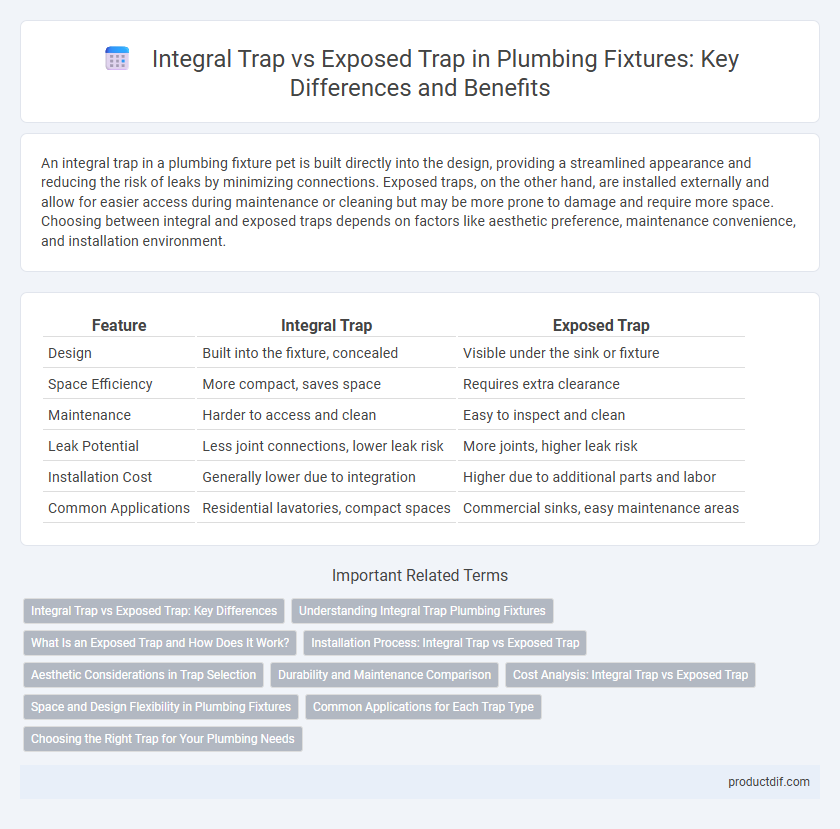An integral trap in a plumbing fixture pet is built directly into the design, providing a streamlined appearance and reducing the risk of leaks by minimizing connections. Exposed traps, on the other hand, are installed externally and allow for easier access during maintenance or cleaning but may be more prone to damage and require more space. Choosing between integral and exposed traps depends on factors like aesthetic preference, maintenance convenience, and installation environment.
Table of Comparison
| Feature | Integral Trap | Exposed Trap |
|---|---|---|
| Design | Built into the fixture, concealed | Visible under the sink or fixture |
| Space Efficiency | More compact, saves space | Requires extra clearance |
| Maintenance | Harder to access and clean | Easy to inspect and clean |
| Leak Potential | Less joint connections, lower leak risk | More joints, higher leak risk |
| Installation Cost | Generally lower due to integration | Higher due to additional parts and labor |
| Common Applications | Residential lavatories, compact spaces | Commercial sinks, easy maintenance areas |
Integral Trap vs Exposed Trap: Key Differences
Integral traps are built directly into plumbing fixtures, providing a seamless design that reduces leak points and simplifies installation. Exposed traps are external to the fixture, allowing easier access for maintenance and cleaning but potentially compromising aesthetic appeal. The choice between integral and exposed traps impacts durability, ease of repair, and overall bathroom or kitchen design.
Understanding Integral Trap Plumbing Fixtures
Integral trap plumbing fixtures incorporate the trap within the fixture design, eliminating the need for separate trap installations and reducing potential leak points. This type enhances water seal reliability by ensuring a consistent trap volume and positioning, which helps prevent sewer gas odors and improves sanitation. Integral traps also simplify maintenance and installation processes, making them a practical choice for modern plumbing systems.
What Is an Exposed Trap and How Does It Work?
An exposed trap is a plumbing fixture component located outside the wall or under the sink, designed to prevent sewer gases from entering the living space by maintaining a water seal. Unlike integral traps, which are built into the fixture itself, exposed traps are visible and accessible for easier maintenance and cleaning. These traps work by capturing a small amount of water in the curved section of the pipe, creating a barrier that blocks odors and gases from the drainage system.
Installation Process: Integral Trap vs Exposed Trap
Integral traps simplify the installation process by being pre-fabricated as part of the plumbing fixture, reducing the need for additional fittings and minimizing potential leak points. Exposed traps require more precise alignment and additional components during installation, increasing labor time and the risk of improper sealing. Choosing integral traps can accelerate project timelines and lower installation complexity, especially in confined spaces.
Aesthetic Considerations in Trap Selection
Integral traps provide a streamlined appearance by being built directly into the plumbing fixture, reducing visible pipes and enhancing bathroom aesthetics. Exposed traps, often made from chrome or polished materials, can serve as decorative elements but may disrupt minimalist design schemes. Selecting between integral and exposed traps depends on the desired balance between visual appeal and maintenance accessibility in bathroom design.
Durability and Maintenance Comparison
Integral traps offer enhanced durability due to their seamless design, reducing potential leak points and minimizing wear over time. Exposed traps, while easier to access for maintenance and cleaning, are more susceptible to physical damage and corrosion, potentially leading to higher repair frequency. Choosing between the two depends on balancing long-term durability needs with the convenience of routine maintenance access.
Cost Analysis: Integral Trap vs Exposed Trap
Integral traps typically reduce installation costs by combining the trap and fixture into a single unit, minimizing labor and material expenses. Exposed traps, while easier to inspect and maintain, often incur higher costs due to additional piping and potential for increased leak risk. Evaluating total expenses, including repair and maintenance, integral traps generally offer a more cost-effective solution over the fixture's lifespan.
Space and Design Flexibility in Plumbing Fixtures
Integral traps in plumbing fixtures save valuable space by being built directly into the fixture, allowing for sleek, compact designs ideal for small or modern bathrooms. Exposed traps, while occupying more visible space, offer greater design flexibility and easier access for maintenance or aesthetic customization in larger or traditional settings. Selecting between integral and exposed traps depends on prioritizing spatial efficiency or design adaptability in plumbing layouts.
Common Applications for Each Trap Type
Integral traps are commonly used in modern bathroom sinks and faucets due to their compact design and ease of installation, ideal for residential and commercial settings requiring a streamlined appearance. Exposed traps are frequently found in older buildings and commercial kitchens where maintenance accessibility is crucial, allowing for quick inspection and cleaning. Both types serve essential functions in preventing sewer gases from entering living spaces, but the choice depends on application-specific needs such as aesthetics and maintenance convenience.
Choosing the Right Trap for Your Plumbing Needs
Selecting the right trap for your plumbing system involves understanding the differences between integral traps and exposed traps. Integral traps, built into the fixture, provide a compact, leak-resistant solution ideal for space-saving and modern designs, while exposed traps are easier to access for maintenance and are commonly used in commercial or traditional settings. Consider factors such as ease of cleaning, aesthetic preferences, and installation requirements to ensure optimal function and compliance with local plumbing codes.
integral trap vs exposed trap Infographic

 productdif.com
productdif.com